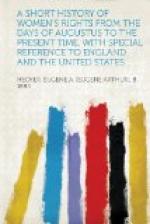The first female seminary to approach college rank was Mt. Holyoke, which was opened by Mary Lyon at South Hadley, Mass., in 1836. Vassar, the next, dates from 1865; and Radcliffe, the much-abused “Harvard Annex,” was instituted in 1879. These were the first colleges exclusively for women. Oberlin College had from its foundation, in 1833, admitted men and women on equal terms; although it took pains to express its hearty disapproval of those women who, after graduation, had the temerity to advocate political rights for women—rights which that same Oberlin insisted should be given the negro at once. In 1858, when Sarah Burger and other women applied for admission to the University of Michigan, their request was refused.
[Sidenote: First women in medicine.]
It was hard enough for women to assert their rights to a higher education; to enter a profession was almost impossible. Nevertheless, it was done. The pioneer in medicine was Harriet K. Hunt who practised in Boston from 1822 to 1872 without a diploma; but in 1853 the Woman’s Medical College of Pennsylvania conferred upon her the degree of Doctor of Medicine. The first woman to receive a diploma from a college after completing the regular course was Elizabeth Blackwell, who attained that distinction at Geneva, New York, in 1848. The first adequate woman’s medical institution was Miss Blackwell’s New York Infirmary, chartered in 1854. In 1863, Dr. Zakrzewska, in co-operation with Lucy Goddard and Ednah D. Cheney, established the New England Hospital for Women and Children, which aimed to provide women the medical aid of competent physicians of their own sex, to assist educated women in the practical study of medicine, and to train nurses for the care of the sick.[411]
[Sidenote: In law.]
In law, it would seem that Mistress Brut practised in Baltimore as early as 1647; but after her the first woman lawyer in the United States was Arabella A. Mansfield, of Mt. Pleasant, Iowa. She was admitted to the bar in 1864. By 1879 women were allowed to plead before the Supreme Court of the United States.[412]
[Sidenote: In the ministry.]
Coming now to the consideration of the ministry, the first woman to attempt to assert a right to that profession was Anne Hutchinson, of Boston, in 1634. She was promptly banished. Among the Friends and the Shakers women like Lucretia Mott and Anne Lee preached; and among the primitive Methodists and similar bodies women were always permitted to exhort; but the first regularly ordained woman in the United States appears to have been Rev. Antoinette Brown Blackwell, of the Congregational Church who was ordained in 1852. In 1864 Rev. Olympia Brown settled as pastor of the parish at Weymouth Landing, in Massachusetts; and the Legislature acknowledged marriages solemnised by women as legal. Phebe Hanaford, Mary H. Graves, and Lorenza Haynes were the first Massachusetts women to be ordained preachers of the Gospel; the latter was at one time chaplain of the Maine House of Representatives. The best known woman in the ministry at the present day is Rev. Anna Howard Shaw, a Methodist minister, president of the National American Woman’s Suffrage Association.[413]




